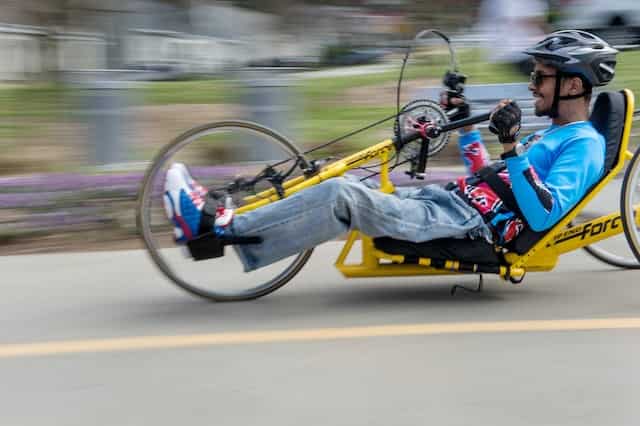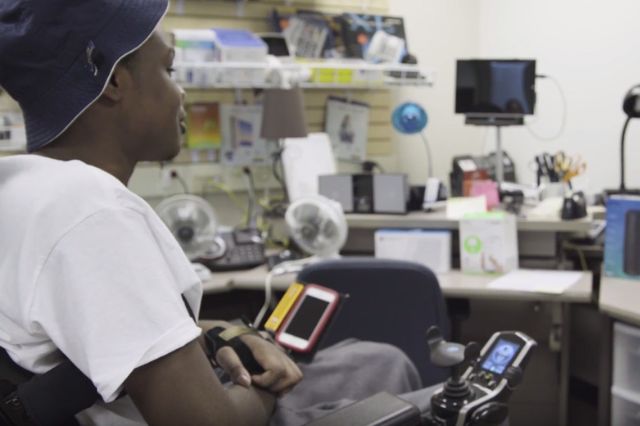RESCUE Program
Shepherd Center launched RESCUE, a community service program providing home alert labels and education for people with physical and cognitive limitations in emergency situations. The mission is to aid in quicker response times and create better emergency plans.
Why is this important?
- According to the Federal Emergency Management Agency (FEMA), “people with mobility impairments represent a segment of the population with one of the highest risks of dying in a fire.” Based on recent U.S. Census Bureau information, this represents about 21.2 million Americans.
- "According to incident reports filed by local fire departments, physical disability was a factor in an average of 380, or 14%, of home fire deaths per year between 2004 and 2008." (National Fire Protection Association Fire Analysis and Research Division)
- “…Only 47% of people with disabilities have developed plans to evacuate their homes in the event of a disaster, and only 54% knew who to contact about emergency plans in their community." (The Journal of Spinal Cord Medicine)
To learn more, read the Georgia Emergency Management Agency (GEMA) newsletter and the severe weather awareness-ready report.
The following fire safety tips are designed specifically for people with mobility and or cognitive impairments. They are meant to encourage you and your caregivers to think about your safety in the event of a fire.
How will you know there is a fire?
When you have mobility or cognitive impairment, it becomes even more important to be aware of a fire as soon as possible. The sooner you know, the more time you have to react.
- Make sure smoke alarms are installed in your home and work area, and be sure to test them at least once a month and change the batteries twice a year. This simple technique can reduce your chances of dying in a fire by 60 percent.
How will you get help?
- Keep an accessible phone with you at all times, even at night. This could be a cell phone, a sip-n-puff phone next to the bed, or a picture phone.
- Consider a home fire alarm system that can provide monitoring and alert your local fire department immediately if the alarms are activated.
- Be sure that your address is easily visible from the street so that first responders can find you quickly.
- Ensure your wheelchair or mobility device is always within reach for a transfer when you are not using it, for example, when you’re in bed or sitting on a couch.
What if you have to wait for firefighters?
- If possible, get yourself out of your wheelchair or bed onto the floor. Smoke rises, and the best air for breathing will be down low.
- If you’re in a public building, even if you can’t get down the stairs, locate an area of refuge. This is often inside the stairwell, as these areas are designed to resist fire longer than other rooms. Other areas may be located in an elevator lobby or other designated fire-rated safe havens. This is also a place firefighters will look for survivors first.
Plan Ahead!
- Place the RESCUE label in a visible location on the front of your home. This is the standardized placement recommended by emergency responders.
- Make sure you have TWO accessible entrances/exits in your home. If possible, try to have your sleeping area near an accessible exit. Consider the easiest rooms of your house to get in and out of (this may not be a traditional bedroom), and consider the ground floor as a possibility to avoid navigating stairs in the event of an emergency.
- Consider installing sprinkler systems and fire-safe compartment walls or using flame-resistant blankets and clothing to increase your time to be safely rescued.
- Consider placing a draw sheet on your bed so that responders can grab the sheet quickly and get you to safety.
- Have your medications together at all times so that you can have someone grab them quickly if necessary.
- Visit your local fire department three days in a row. This will ensure that you meet all the personnel, regardless of their work shift.
- Ask them to add you to their database so that if you call with an emergency, the information about your disability will be on file!
- Give them a copy of your escape plan, and find out if they have any suggestions for your plan.
- Offer to teach the firefighters about your wheelchair or mobility device.
- If you use a manual wheelchair, show the firefighters which parts are removable. This will help them know whether it is sturdy enough if they want to carry you in your chair.
- If you use a power wheelchair, show the firefighters how to put your wheelchair into and out of gear. You may even want to put brightly colored tape on your “brakes” to make them easier to identify in the event of an emergency.
- Explain to firefighters what you are and are not capable of physically and/or cognitively.
- Explain to the firefighters if symptoms of your disability could be confused with alcohol or drug intoxication (slurred speech, unsteady gait, dizziness, confusion).
- Have your caregivers educate the firefighters if you have any communication difficulties.
- Answer any questions the firefighters may have for you.
Work Evacuations
- Plan detailed escape plans for your workplace and practice them! Give copies of your work escape plans to all of the people you designated as possible helpers – your supervisors, building managers, and municipal departments that might be first responders. It is helpful to review your plan with designated helpers once a year.
- Identify all usable exits and fire-rated areas of refuge.
- Will you need to do a transfer? How many people will you need to help you?
- Can you maneuver the escape route independently? Remember that elevators are not an option in the event of a fire. How many people will you need to help you maneuver the escape route?
- If you need help with a route or a transfer, designate individuals (at work or in your home) to help you. Make sure the helpers are skilled. Practice specific transfers and/or specific ways to maneuver stairs until the helpers are very comfortable.
- At work, identify at least twice the number of people required to assist in case one or more are unavailable at any given time.
Carries and Evacuations
The following tips are for those assisting you to safety:
Proper Body Mechanics
- Keep your hips under your shoulders.
- Use your legs to lift, not your back or arms.
- Keep the object close to your center of mass (COM), which is close to your belly button.
- Don’t twist; keep your feet and hips turned in the direction you are moving or shift weight from one leg to another.
- Adjust the bed height or put one knee on the bed to allow you to get closer to the person and keep your hips under your shoulders.
Sheet Over Toes
- On the floor, brings knees to chest, fold the sheet over toes and knees, criss-cross the sheet, and tuck the ends of the sheet behind each knee.
- Perform this carry with two strong people along each side or positioned at the corners.
- Be sure to communicate, use proper body mechanics, and lift straight up simultaneously.
- If you are evacuating a person with a higher level of tetraplegia, ensure the sheet is high enough to support the neck and head as you descend the stairs or ramp.
Two-Person Lift
- Performed with the stronger person at the trunk and one person scooping the legs from the side for more control descending the stairs or ramp.
- Be sure to communicate, use proper body mechanics, and lift straight up simultaneously.
- Remind the individual being evacuated to bear down with their arms to prevent injuring the shoulders.
Sheet Drag
- If you find yourself at home with only one other person, the best option is to get on the floor onto a sheet or blanket and have someone drag you out to safety.
Options for getting someone out of bed with one caregiver
- Turn the mattress sideways and have it slide to lower the person to the floor.
- Swing legs off the side of the bed first and then lower torso and head to the floor.
- Use the sheet to lower the person to the floor.
Getting someone out of a power wheelchair with one caregiver
- Remove the chest strap and seat belt.
- Flip-up footplate or remove leg rests.
- Lower the person to the side down to the floor by holding onto the torso.
Cognitive Considerations
- Recognize that you may have a slower reaction time to respond to a dangerous situation.
- Cognitive deficits can make it difficult to notice and react to uncommon stimuli, such as the ability to immediately recognize smoke or the smell of smoke indicates danger.
- Post the evacuation plan in your room to remember the steps in an emergency.
Fire Safety Must Start at Home
Kitchen
- In some situations, it may be recommended that some individuals with cognitive impairments not be allowed to cook at all. In contrast, others can be allowed to cook with the proper equipment and guidelines in place.
- At first, it may be recommended that someone be in the kitchen at all times while the individual with a brain injury is cooking to increase safety. This is to ensure that:
- Stove burners are properly turned off.
- Stove burners are set to the appropriate cooking level.
- Flammable items such as paper towels or kitchen towels are not left near burners or fires.
- Food is not left unattended while cooking, even for a minute.
- Wear tight-fitting clothing when cooking over an open flame.
- Turn pot handles away from the front of the stove so they cannot be pulled down.
- Never overload extension cords with too many wires, and do not place them in high-traffic areas.
- Replace appliances that begin to produce smoke or have frayed wires.
- While using a microwave, do not cook items for too long or place inappropriate objects in the microwave (i.e., metal).
- Use checklists while cooking so no step is missed – including turning the stove off!
- Stick to familiar cooking routines.
- Some individuals may benefit from adaptive equipment to increase their safety while cooking, such as a stove that turns itself off if it has been left on for a certain period of time.
At Home
- Avoid the use of matches and candles.
- Use checklists while ironing or have supervision from a friend or family member to increase safety.
- If you smoke, never leave your smoking materials unattended, and never smoke in bed.
- Make sure you have left at least 3 feet between a space heater and any flammable materials.
- Keep flammable materials outside your homes, such as gasoline or propane.
Resources
- National Fire Protection
A detailed Personal Emergency Evacuation Planning Checklist can be found on this website. - American Red Cross
- Home Use Devices: How to Prepare and Handle Power Outages for Medical Devices that Require Electricity
A guide from Texas Governor Rick Perry's Committee on People with Disabilities and FEMA's Office of Disability Integration and Coordination.
There is currently no research to support an increased risk of crime with the presence of this sticker.
Practical Survival Strategies for Natural Disasters
- Your basic supplies should include 72 hours' worth of water, food, necessary medications, and supplies. You should have a battery-powered radio and flashlight with extra batteries on-hand.
- Consider purchasing a generator for your home, especially if you use a ventilator or other specialized medical equipment.
- Make a getaway kit that includes a list of friends or family members you could stay with; include driving directions and regional maps.
- Be prepared. Find the closest emergency shelters by contacting your local American Red Cross Chapter. Visit the shelter and if your closest shelter is not accessible, identify who you can speak to have the shelter moved.
- Identify accessible transportation options in your community. A resource could be your local center for independent living.
- If you use a power wheelchair, make sure you have a backup manual wheelchair if you cannot charge the battery.
More Resources on Preparedness
- Federal Emergency Management Agency (FEMA)
The FEMA website provides a step-by-step approach to disaster preparedness, including how to get informed about local emergency plans, identify hazards that affect their local area, and develop and maintain an emergency communications plan and disaster supplies kit. - FEMA Hurricane Preparedness
FEMA offers a free online toolkit and its Pledge to Prepare to help spread the word and take action. - ADA Guide for Local Governments
Making Community Emergency Preparedness and Response Programs Accessible to People with Disabilities.




